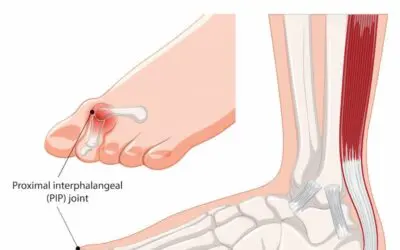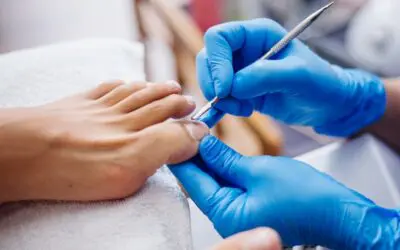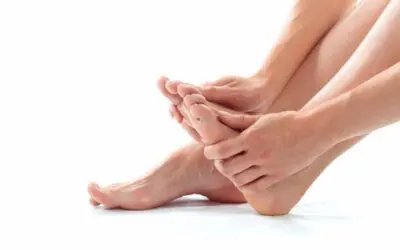If every step feels like a protest from your big toe, you’re not alone. Bunions are the foot’s not-so-silent way of saying, “Hey, something’s not right down here!”
When you first notice that bump forming at the base of your big toe, it might seem like a minor irritation. But as time passes, it becomes more than just a cosmetic concern. It interferes with your ability to walk comfortably, fit into shoes, or participate in your favorite activities. That’s a bunion for you. It’s a progressive joint deformity that can significantly impact your quality of life.
A bunion happens when the joint at the base of your big toe starts to shift out of place. Your big toe angles inward toward the others, causing the joint to protrude outward. This misalignment leads to inflammation and pain, especially when wearing narrow or tight shoes.
If you notice pain in that area, especially during activity or after long hours on your feet, you’re likely experiencing bunion-related discomfort. If you’re limping or swapping stylish shoes for extra-wide sneakers just to get through the day. It’s time to talk about bunion pain treatment and when it might be time to stop tiptoeing around the idea of surgery.
Simple Ways to Relieve Bunion Pain at Home
Managing bunion pain doesn’t always require a trip to the operating room, especially if you catch it early or your symptoms are still mild. With consistent care and a few lifestyle adjustments, you can reduce discomfort and slow the progression of the deformity.
Change Your Footwear
This step alone can put you on the road to relief. Avoid high heels and narrow-toed shoes that squeeze your toes together. Instead, choose shoes that have a wide toe box, proper arch support, and cushioned soles. You might feel like you’re sacrificing fashion for function, but your feet will thank you in the long run.
Add Padding
Padding the bunion is another effective way to reduce irritation. Gel pads or moleskine protectors can help reduce friction between your bunion and the side of your shoe. Over-the-counter options are widely available and easy to apply.
Elevate
Cold therapy can also bring relief, especially after a long day. Icing your bunion for 10–15 minutes can reduce swelling and soothe the area. Pair that with some elevation, and your discomfort may lessen noticeably.
Space It Out
You may also benefit from toe spacers or splints that help gently realign the toe while you rest or sleep. While these won’t fix the bunion permanently, they can improve comfort and reduce stress on the affected joint.
Ease Inflammation
Finally, consider nonsteroidal anti-inflammatory drugs (NSAIDs) like ibuprofen if the pain flares up. Just be sure to consult your doctor before taking any medication regularly. It’s not about walking on sunshine. It’s about walking without wincing.
Stretching and Strengthening: Support for Your Feet
You might not realize how much control you have over your bunion symptoms just by using your feet more intentionally. Specific stretches and exercises can help improve foot flexibility, strengthen the muscles surrounding the joint, and increase overall stability. These moves may look small, but they pack a punch in the fight against bunion pain.
For example, try gently pulling your big toe until it aligns with your others and hold it there for several seconds. Or consider towel curls, where you place a towel on the floor and use your toes to scrunch it up. These small exercises engage the foot muscles and can support better balance and posture. They’re like personal training for your feet. No gym membership required.
Even calf stretches can help, especially if tight muscles contribute to misalignment in your stride. The more flexible and supported your lower leg is, the less stress gets funneled into your forefoot and bunion area.
Think of this like training your foot’s “core.” When those deep muscles are strong and responsive, your foot is more resilient, and the bunion pain you experience may become more manageable during daily activities. Your bunion-prone feet will thank you for the extra flexibility.
When Conservative Treatments Aren’t Enough
At some point, you may start asking yourself a tougher question: “When is it time to consider surgery?” This is a decision to take seriously. Always discuss it with a podiatrist first.
You should start thinking seriously about surgical options if:
- Your bunion pain is constant and interferes with your ability to walk or stay active.
- You can’t find shoes that fit comfortably, even with wide or orthopedic options.
- The bunion continues to grow or shift, causing changes to your gait or posture.
- You’ve tried padding, orthotics, and exercises without meaningful relief.
If you experience pain every day that impacts your lifestyle or causes secondary issues like corns, calluses, or hammertoes, surgery may offer long-term relief. Seek help quickly if the deformity begins to affect your balance or mobility.
Bunion surgery isn’t a one-size-fits-all procedure. Depending on the severity and structure of your bunion, your podiatrist may recommend anything from a minimally invasive correction to a more involved joint realignment. Think of bunion surgery not as defeat, but as hitting the reset button for your feet.
Preparing for a Bunion Surgery Consultation
If you’ve reached the point where surgery seems like the next logical step, go into your consultation informed and confident. Your podiatrist will likely evaluate your bunion with X-rays, assess how it affects your movement, and ask about your history with pain and previous treatment attempts.
Share with your doctor how the bunion has affected your lifestyle. Is it preventing you from exercising, hiking, working comfortably, or even standing for long periods? Those details help shape your care plan. Your podiatrist isn’t a mind reader, so bring the whole story, bunion drama and all.
Remember, just because you’re consulting about surgery doesn’t mean you’ll need it right away. In many cases, providers will walk you through both non-surgical and surgical options to weigh all possibilities.
Your recovery time will depend on the procedure chosen. Some surgeries allow immediate weight-bearing in a walking boot, while others may require crutches or limited activity for several weeks. Ask about the post-op expectations upfront to prepare and plan your recovery without surprises.
The Next Step Toward Relief
Whether you’re managing mild bunion pain or considering surgery for a long-standing deformity, don’t just wait. The earlier you take action, the more options you’ll have and the better your outcome will likely be.
If you’re in Utah and dealing with bunion pain, look for a “toe clinic near me,“ like the Foot & Ankle Center, which provides comprehensive evaluations and custom treatment plans to help you regain your comfort and mobility. From non-invasive relief to expert surgical care, you’re gaining a team invested in your long-term foot health.
Your feet carry you through life. Taking care of them now, whether through simple home remedies or surgical intervention, can make every step ahead more comfortable.



